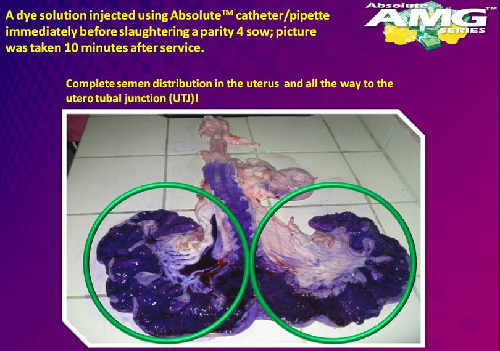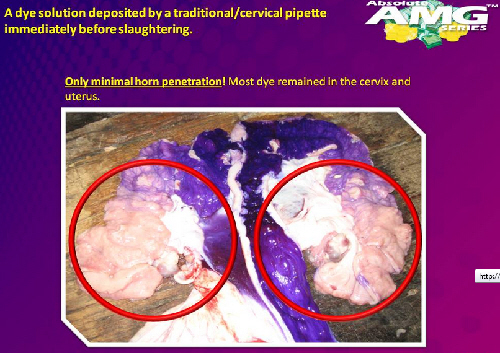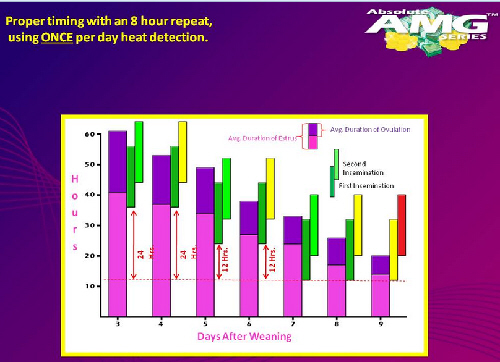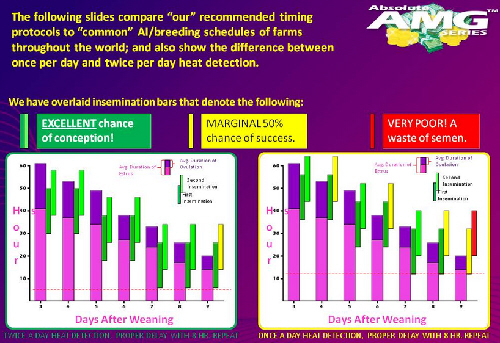



AI, IUI or DIUI: Which One is Right for My Farm?
US - An artificial insemination (AI) device could give you a 5,000-per cent Return on Investment (ROI), according to Absolute Swine Insemination Company (ASIC).Decades ago, a novel approach to pig breeding was introduced that is nowadays status quo. When the new technology was first introduced, it took special people, leaders in the industry, and people with a vision to take a risk and 'change' the way they had always bred in the past. Yes, we are talking about 'traditional cervical artificial insemination' (or AI), says ASIC.
Although the advantages were many, there were sceptics that refused to adapt to the new technology, regardless of its benefits and additional profit it could create for the farm.
Change is very difficult for many people to accept at times; and today’s options pose even more considerations. With that said, let us begin by defining the acronyms AI, IUI, DIUI, and a hybrid of IUI and DIUI (Absolute’s AMG Series™).
AI, or traditional Artificial Insemination simply uses a tubular pipette with a foam tip and usually a soft rubber end to accept a variety of semen containers. This is a cervical insemination; meaning that the foam tip is lodged into the beginning of the cervix, and the sow or gilt draw the semen from the bottle, flat pack, or tube via contractions when she is stimulated. Usually, there is a boar present, and/or a technician that rubs the flanks, administers back pressure and performs other types of stimulation to assist (or bring on) the animal’s contractions.
IUI, or “Intra-Uterine Insemination” generally consists of a relatively small diameter rigid tube, inside a regular traditional pipette. This smaller tube is gently pushed through the cervix and directly into the uterus.
While there can be advantages to this method, it has been relatively slow to catch on due to the potential of hurting the animal by scraping or puncturing delicate tissues in the reproductive tract. These dangers can be magnified since this type of pipette also collects a small amount of bacteria laden matter when it is threaded through the cervix. Even when the process is performed by highly trained technicians or Veterinarians, there is no way of keeping this little plug of unmentionables out of the reproductive tract.
The cervix’s primary role is to keep bacteria and contaminants from entering the uterus and uterine horns (the animal’s reproductive tract). Once this substance enters the uterus, the animals are more prone to infections, abortions, smaller litter sizes, and lesser farrowing percentages.
Next we have the DIUI, or Deep Intra-Uterine Insemination. This is a very controversial procedure; one that uses a thin flexible tubular pipette that is approximately 1.7 metres in length. The extreme length of this tube allows it to be inserted all the way to the UTJ (uteral tubal junction) where its design allows it to place very small amounts of semen (albeit in only one horn).
For more information on this process from the Center for Advanced Technologies in Animal Genetics and Reproduction (Rerogen) at the Faculty of Veterinary Science, University of Sydney, Australia, visit www.ncbi.nlm.nih.gov/pubmed/17275224 ('Investigation of the uterine lining after insertion of the DIUI catheter revealed evidence of bleeding, warranting further investigation of the viability of widespread use of the Firflex® catheter, despite the promising fertility achieved here with low doses of spermatozoa.')
A presentation was produced by Dr Don Levis of the Ohio Pork Industry Center, Ohio State University, and Swine Veterinary Center; among others. Slides 28-32 relate to the AMG Series catheter when it was called the Absolute Catheter and slides 33-35 are specific to the FirFlex® DIUI model of catheter.
Will There Be a Welfare Issue?
Don G. Levis, PhD
Needless to say, this method of breeding might work in clinical trials performed by elite doctors in their trade; but this technology is not ready for mainstream use in production farms. Going to such extremes to save a few milliliters of semen, hardly justifies the risks and difficulties of integrating this technology into main-stream production farms.
There is a better way! Absolute Swine Insemination Co., LLC (ASIC) combines the performance of DIUI and the relative safety of traditional cervical inseminations with their hydraulic AMG Series catheters; and they do it safely and effectively in 'both' horns at the same time.
ASIC’s patented technology has a very flexible membrane hiding inside their specially designed plastic catheter. This membrane moves forward when a technician squeezes on the semen tube, flat pack, bottle, or any semen container in the market today. Since the AMG pipette’s membrane turn itself inside out while moving forward, the aforementioned plug of bacteria is actually re-deposited at the very beginning of the cervix. The only substance entering the reproductive tract of your animals is what is inside the semen container.
Immediately below is a picture of a parity 4 sow’s reproductive tract. This animal was 'injected' with a dye substance using the AMG Series of catheters. Immediately after injecting the dye, the animal was culled and her reproductive tract was removed and opened. As you can see, the dye advanced up both horns to the UTJ instantaneously without any injury or risk to the animal.

The picture below is also of a parity 4 sow bred using a traditional foam tip pipette. As you can see, the majority of semen is trapped in the cervix and some has advanced a short distance up the horns. The semen still has a long way to travel prior to reaching the UTJ awaiting ovulation; but more importantly, most of the semen will die along this journey due to phagocytosis.

For a full explanation of the 'Transport and Loss of Boar Spermatozoa in the Reproductive Tract of the Sow', published by the Journal of Animal Science; by N.L. First, R.E. Short, J.B. Peters and F.W. Stratman can be read by clicking here: jas.fass.org/content/27/4/1037.full.pdf.
With that said, it is essential the semen reaches the UTJ in the shortest amount of time possible. The article link above references the time span being anywhere from 10 minutes to five hours; the jury is not always in agreement in these matters. In the trials ASIC performed, the semen reached the UTJ and was in safe storage virtually instantaneously. This is a very important aspect of ASIC’s success. Filling the UTJ with fresh viable semen gives you much greater odds at fertilising the largest number of oocytes during ovulation. It is simple common sense; isn’t it? The greater the number of strong viable semen that have not undergone the death march through the horns is undoubtedly going to give you better performance.
The AMG Series of catheters are much more than a hybrid artificial insemination tool. They are tools that when used properly can offer incredible profits for your farms bottom line. This technology is not for everyone; it requires ambitious people with a positive attitude that believe good performance is not always good enough! In order to monitor and calculate profits, farms and personnel need to maintain good records and documentation; they also need people willing to study understand and believe in ASIC’s suggested timing protocols.

One such gentleman that has these qualities and welcomed change is Mac Magee of Commercial Concepts AI, Inc. He has taken four units to outstanding new heights; and he has been considerate enough to share the statistics with us for this article.
Please click on any chart or spreadsheet (a full screen file will open) to see the improvements accomplished using the AMG Series™ with ASIC’s recommended insemination timing protocols.
Before and after performance on sows
To view the results, click here.
Collectively, the sows serviced by ASIC’s technology provided $424,944.00 in extra annual profit.
The ROI in the group ranged from a low of 498 per cent with the highest being 4,866 per cent.
Before and after performance on gilts
To view the results, click here.
Collectively, the gilts serviced by ASIC’s technology provided US$252,716.00 in extra annula profit.
The ROI in this group ranged from a low of 662 per cent, with the highest being 5,431 per cent.
Performance like this is not achieved by a magic wand catheter; it requires good management, accurate heat detection, genetics, nutrition, vaccination programmes, accurate record keeping, and of course good technicians.
This is where the second phase of the AMG Series both differs and excels over conventional AI methods. ASIC’s timing protocols are based on individual animal’s physiology; there is no blanket system where you breed all animals on the fourth or fifth day post weaning and the animals are also heat-checked and bred twice per day (AM and PM).
Many of you at this stage will simply say you cannot do that or do not have the crew or the time (This is where the positive attitude plays its role). When you can breed your animals on an average of one minute or less per service, a great deal of time is provided for you, simply due to the speed of servicing. Your crew will have more time to spend accurately heat detecting and all the other chores at hand that consumed the time necessary to heat detect and breed twice a day before.
The first part of any successful breeding program is of course, heat detection. If your people are breeding animals too early or too late, your results will be meager. If you breed like many examples shown in a downloadable PowerPoint Presentation a little further in this article, you will easily see how important the heat detection and timing actually is.
The figure below depicts our recommended protocols which overlap ovulation almost perfectly. Heat detection was performed twice per day as well as breeding. The green bars are the semen doses and the purple portion of the bar is ovulation.

Please notice how the duration of oestrus shortens everyday post weaning. Both oestrus and ovulation cycles become shorter as the days after weaning become greater.
The next slide represents the same graph, with the only difference being this group was heat checked only once per day. We use green, yellow, and red just like traffic lights. Green is a go, yellow is use caution, and red means stop; you will either waste your dose of semen or you could abort the animal if she conceived during the first insemination and no longer was in oestrus and/or ovulating.

The next slide shows comparison in accuracy between twice per day heat checking and once per day.

The ASIC Insemination Timing Suggestions PowerPoint presentation can now be viewed on any Windows-based computer. There is no need for you to have PowerPoint installed. You will be amazed how some very common and accepted procedures end up being so wrong. It is hard to imagine or explain in words; therefore the slides are animated to help make our point. We could write a book about our procedures and benefits your farm can achieve. Actually, we have done better than that.
You can now view ASIC's entire tutorial presentation online anytime, anywhere without signing up. ASIC says it could write a book about its procedures and benefits your farm can achieve.








